Nate Silver's Blog, page 159
December 18, 2014
Every NBA Team’s Chance Of Winning A Title By 2019
I can see Madison Square Garden from my Manhattan apartment. This year, the arena installed LED lights along the exterior columns of the building — blue, red and white for New York Rangers games; orange and blue for New York Knicks games. They outshine everything else along a drab stretch of Eighth Avenue. When the Knicks colors shine, I’m reminded that there’s a dreadful basketball team playing a few blocks from me.
The Knicks are 5-22 on the year, on pace for their worst season in the not-exactly-glorious history of the franchise. But unlike a lot of bad teams, the Knicks are not yet in rebuilding mode. Their only players to have performed at an above-average level so far this season1 are 30-year-old Carmelo Anthony, 32-year-old Amar’e Stoudemire and 37-year-old Pablo Prigioni. They have a few (not many) good players and a few (not many) young players, but there’s almost no overlap on the Venn diagram.
Just how dire is the Knicks’ situation? Are they worse off than the Los Angeles Lakers? Than the Philadelphia 76ers, who very much are in rebuilding mode and are 2-22?
Let’s take a longer view. What are the chances any of these franchises will field a championship-caliber team over the next five seasons (from this year through 2018-19)? On the flip side, which NBA franchise has the most reason to be optimistic about its future? Would you rather be the Cleveland Cavaliers or the Golden State Warriors? Would you rather be the Memphis Grizzlies, with a sterling record so far this season but no superstar, or the New Orleans Pelicans, who aren’t so good yet but have a potential world-beating talent in Anthony Davis?
There have been some valiant attempts to answer such questions before (see ESPN’s NBA Future Power Rankings). Our method here will be simpler and more statistically driven. The idea is to project the number of NBA championships a franchise might expect to win over the next five seasons based on three easily quantifiable factors:
How good is the team now?How old the team?How good is its best player?To be clear, we are not claiming these are the only things that matter. You’d probably want to give a team some extra credit if it’s run by a genius like Gregg Popovich. You’d probably want to dock it if it has traded away some of its future draft picks (as the Knicks have) or if its salary cap situation is poor. And our approach will not be so great at handling teams with injuries to star players. But simple models like these can be a useful tool for understanding how NBA franchises evolve.
Some modestly technical bits follow. You can skip ahead a few paragraphs if you’re not sweating the small stuff.
As I mentioned, our goal is to estimate the likelihood of a team winning an NBA championship over the next five seasons. The method won’t give much credit to a team for being just decent. Unlike in certain other sports, an NBA team almost never backs into a championship by being slightly above average and then getting lucky in the postseason. A 52-win team in the regular season will win the NBA championship only about 2 percent of the time; a 64-win team will win it something like half the time.
More specifically, the model takes the form of a logistic regression analysis where the inputs are three factors I described above — age, overall team quality and the quality of its best player — and the output is the projected number of championships won.2 I’ve used data from the ABA-NBA merger season of 1976-77 onward.
To measure overall team quality, I’ve used the number of games a team won.3 But when looking toward future seasons, a team’s most recent win-loss record isn’t all that matters; so does the distribution of its talent. The presence of an actual or potential superstar significantly improves its chances of winning championships.
This shouldn’t be surprising. In the NBA’s economic structure, there are two types of players who routinely produce a high return on investment: young players (who often make far less than they would as free agents under the rookie salary scale) and superstar players (who are often underpaid because of the maximum salary). Teams built around superstars face downside risk; if the superstar leaves town or gets hurt, they’re screwed. But in the NBA, you’d rather take a high-risk, high-reward approach than settle for a No. 8 seed every year.
Our measure of superstar talent is how a team’s top player rated according to the statistic “wins added,” which is described at more length here. Wins added is based on a combination of Win Shares and Player Efficiency Rating (PER). Neither metric is perfect (far from it), but because each can be computed from readily available “box score” statistics, they allow us to compare players and teams on a level playing field dating back to 1976-77.
Having a younger team helps, of course, but it’s better to evaluate the age of a team’s best players rather than everyone on its roster. So, our calculation of a team’s average age is weighted based on wins added.4 This is important. The average New York Knick, weighted based on the number of minutes played this season, is about 28 years old. But the team’s better players are old; its average age is closer to 30 when weighted by wins added.
There are a couple of further details in the footnotes,5 but let’s see how this works in practice. Here’s how the 30 NBA teams ranked in future championship potential based on their statistics at the end of last season. We’ll run the numbers based on the current season’s data in a moment.

At the end of last year, the Oklahoma City Thunder had the most hopeful situation in the league, projecting to win 0.8 championships over the next five years. This total includes cases where the Thunder would win multiple championships, so this is not quite the same as saying they had an 80 percent chance of winning at least one championship. (Titles in the NBA can come in bunches.)
Still, this was a reasonably impressive figure; since 1976-77, only 12 teams had a better projection. The top one belonged to the Chicago Bulls going into the 1996-97 season. They projected to win 1.2 more championships to go with the four that Michael Jordan had won already; Jordan won two more in reality.
But the NBA is a tough league. Some of the teams that projected almost as highly as Jordan’s Bulls never won a championship. The Cleveland Cavaliers projected to win about 1.2 championships over their next five seasons heading into the 2009-10 season — but LeBron James left, and they didn’t win any. (A championship in Cleveland this season now that James has returned would be one year too late to count within the five-year window.) Other teams appeared likely to follow one championship with more but failed to do so. The Philadelphia 76ers, coming off a 67-win championship season in 1982-83, projected to add another title to Julius Erving’s mantle but never did.
Last season is old news, however. So, we’ve also come up with a projection that accounts for roster turnover and a team’s performance so far this year. This required a few modifications to our original model:
Team win totals are projected based on John Hollinger’s playoff odds, which account for potential reversion to the mean.6For individual players, wins added are projected based on a combination of a player’s performance so far this year and in recent past seasons.7Team ages are weighted based on projected wins added.To estimate a team’s chances of winning a title this year (2014-15), I used Hollinger’s playoff odds simulation. For the remaining seasons in the five-year window through 2018-19, I used the figures from our model instead.All projections are based on stats through Tuesday evening.One team is clearly ahead of the pack. It’s the Golden State Warriors.
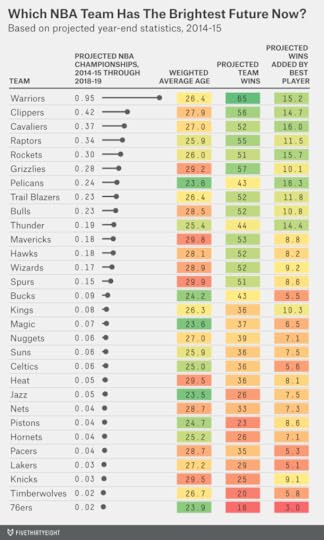
The Dubs project to win 0.95 championships between now and 2018-19. Some of that is because they’re the favorite to win the title this year, according to Hollinger’s method, with a 36 percent chance. But they also rate as the best bet to win the championship in each subsequent season through 2018-19.
This isn’t rocket science: the Warriors are really good. They’re young — in fact, their average age has declined slightly from last year as older players like Andre Iguodala have come to play less important roles. And they have a superstar in Stephen Curry.
Following the Warriors on the list:
At No. 2, the Los Angeles Clippers. They’re not off to the start the Warriors are, and they’re a little older. But they have the talent they’ll need.At No. 3, the Cavaliers, who have a young core surrounding James, but who don’t yet look like they’ll stand head and shoulders above the pack as James’s teams did some years in Miami.At No. 4, the Toronto Raptors, another obvious choice. They’re young, Kyle Lowry is on the verge of being a superstar, and they have the benefit of playing in the Eastern Conference.8At No. 5, the Houston Rockets, whose projection is largely unchanged from the end of last season despite a disappointing off-season.At No. 6, the Grizzlies. Note, however, that this year is probably their best hope of a championship drive. The roster is fairly old, and there’s not a true superstar to build around.At No. 7, the Pelicans. They haven’t gotten off to an especially strong start this year and have little shot of title contention this spring. But Davis has as bright a future as anyone in the league and the team’s average age (weighted by wins added) is just 23.6. They project to be the second- or third-best team in the league by the end of the five-year window, according to the model.At No. 8, the Portland Trail Blazers, whose numbers are similar to the Raptors across the board but who play in the tougher conference.At No. 9, the Chicago Bulls. Theirs is a decent projection, but the Bulls are older than you might think, and Derrick Rose hasn’t played like a superstar lately, even on the rare occasion he’s played. Instead, wins added thinks that Jimmy Butler is their best player.And at No. 10, the Thunder, whose projection has declined more than any other team since the end of last season.

Does this underrate OKC? Yeah, probably. As I’ve said, our simple method is liable to underrate teams dealing with injury problems. The Thunder have played pretty well since Kevin Durant and Russell Westbrook have returned to the lineup. But two points to consider.
First, when a team has the talent the Thunder do, there’s no time like the present to win a title. But the Thunder are unlikely to win the championship this year. They’d be the No. 8 seed in the Western Conference if the playoffs started today, and while Hollinger’s method may underrate them, there’s a big gap between the Thunder and the top seven seeds. Even if they improve to (for instance) the No. 6 seed, they’ll probably have to win four playoff series as the road team to win the Larry O’Brien Championship Trophy. Not. Easy.
Second, Durant is a superstar by any definition, but the degree of superstardom matters. If Durant is the star Sirius, as he was last season, shining brighter than anyone else in the NBA firmament, the Thunder will always have a leg up on the rest of the league, other things held equal. If he’s merely “in the conversation” as the league’s best player, along with Curry, James, Chris Paul, James Harden and Davis, then the Thunder will perennially compete with Curry’s Warriors, James’s Cavs, Paul’s Clippers, Harden’s Rockets and Davis’s Pelicans — but not necessarily beat them.
To be even more geeky about it, championship contention in the NBA is nonlinear function. Being a 56-win team instead of a 60-win team — because, say, Durant has become a half-step slower or more injury-prone — could matter a great deal.
But how overjoyed Gotham would be if blue and orange stood for the Manhattan Thunder and not the Knicks! The Knicks, obviously, will not win the championship this season. And here’s how the model pegs their chances over the next four seasons. In 2015-16, they have a 0.3 percent of winning the title. In 2016-17, their chances are 0.6 percent. And then in the two subsequent seasons, 0.9 percent and 1.0 percent. Overall, there’s about a 3 percent chance the Knicks will win the NBA title in the next five years.
Three percent is not zero percent, so naturally you’ll find the exception to the rule if you dig in deep enough. The 2007-08 Miami Heat, who finished at 15-67, are the most favorable precedent. Their situation wasn’t entirely different from the Knicks’; in a down season, their roster featured one star (Dwyane Wade) and a lot of aging and overpriced “talent” around him. Three seasons later, they signed LeBron James, and in 2011-12 they won the NBA title.
So, maybe the Knicks will luck into Jahlil Okafor in next year’s draft. And maybe Durant signs with them two years from now, and maybe Anthony has a gentle decline. I’m telling you there’s a chance, Knicks fans! It’s just not bloody likely.
The Knicks, however, do not quite have the worst projection in the league; instead that belongs to the 76ers, whose title chances are lower still.
If your eyes are on the long-term, wouldn’t you rather be in a tanking rebuilding situation like Philly than in the predicament of the Knicks or Lakers? Maybe, but the history of teams who have been as laughably bad as this year’s Sixers is not good. Since the ABA merger, 51 teams have finished with fewer than 20 wins in a 82-game season or the equivalent amount in a shortened season. How many of them won a championship in the next five years? Only one — the aforementioned 2007-08 Heat, whose situation was more analogous to that of the Lakers or Knicks than that faced by the 76ers.
The thing about starting from a 15-win baseline is that you can add a 20-win megawatt superstar from the draft, and sign a 10-win free agent, and have another guy develop into a five-win talent … and still be a 50-win team, a No. 5 or 6 seed. It’s not clear there’s anyone on the Sixers’ roster who is a good bet to develop into a better-than-average NBA player. A team like the Detroit Pistons, who at least have Andre Drummond, is about twice as likely to develop into a championship contender, according to the model. The Pistons also face extremely long odds, but you’d rather have Drummond and a slightly inferior lottery position than the other way around. Tanking doesn’t pay, kids!
But there are a lot of ways to be awful in the NBA, and only one team wins the title. Golden State is the best bet to be pouring the champagne soon.

December 17, 2014
Killing ‘The Interview’ Could Cost Sony $100 Million
Sony Pictures Entertainment announced Wednesday that it will pull the planned Dec. 25 theatrical release of “The Interview,” an action-comedy that stars Seth Rogen and James Franco as madcap would-be assassins of North Korean leader Kim Jong Un. The film was the apparent inspiration for a widespread and embarrassing hack of Sony’s servers that U.S. intelligence officials think may have been initiated by the North Korean government.
Sony said it has no further release plans for “The Interview,” including on DVD or video on demand. (Disclosure: In 2009, I conducted a survey research project for Sony Pictures Entertainment.) Before Sony’s decision, several major theater chains announced they would decline to screen the film.
The decision — and the hack — will be costly to Sony. We can look at comparable films to come up with an estimate of how much “The Interview” might have made in theaters had it been released under normal circumstances. The answer: $100 million, give or take.
I came up with that estimate by looking up comparable films on IMDb. Specifically, I looked for films that:
Like “The Interview” were tagged as action-comedies by IMDb;Like “The Interview” were rated R, and;Were released in 2000 or later by a major or “mini-major” American studio.There’s debate about what constitutes an action-comedy and about what constitutes a major studio. But the list of the 22 films this search came up with looks to be pretty reasonable. It includes “Pineapple Express,” a previous collaboration between Rogen and Franco.
These films are listed below, along with their worldwide box office grosses, production budgets and Rotten Tomatoes ratings. All figures in the article are adjusted for inflation.

On average, the comparable films made $114 million at the box office, although with a wide range, from $800,000 for 2005’s “Feast” to $352 million for 2003’s “Bad Boys II.”
These movies aren’t always critical favorites. Their average Rotten Tomatoes rating has been just 53 percent, and no film has scored higher than 85 percent. But audiences like them, and their combination of action sequences and slapstick humor can travel well, sometimes garnering them more box office revenue internationally than in the United States.
These films also rarely involve the nine-figure budgets sometimes associated with full-fledged action blockbusters. Instead, their average production budget has been $46 million.
“The Interview” had looked a typical film from the genre in just about every respect. Its Rotten Tomatoes rating was 53 percent as of early Wednesday evening, exactly matching the average of similar films. And its production budget was $42 million.
Both production budgets and Rotten Tomatoes ratings are predictive of box office grosses. A 1 percent gain in Rotten Tomatoes ratings is associated with a roughly $2 million increase in international box office gross (according to a linear regression analysis). And every additional $1 million in production budget translates to about $2 million more at the box office. If that sounds too good to be true, keep in mind that reported production budgets usually do not include promotion and advertising expenses, which can be substantial for films like “The Interview,” running into the eight figures. (As it happens, a commercial for “The Interview” came on just as we were working on this article.)
The analysis predicts that “The Interview” would earn $104 million at the international box office. The uncertainty on that estimate is wide, but such a figure would be similar to the average for similar films and for “Pineapple Express” in particular.
Of course, the film might have made even more given all the publicity surrounding the hack. If Sony and the theaters have the guts to show the film, I’ll be the first one in line.

December 16, 2014
Is Jeb Bush Too Liberal To Win The Republican Nomination In 2016?
On Tuesday, former Florida Gov. Jeb Bush announced that he will “actively explore” a bid for the White House. While Bush has not yet formed a presidential exploratory committee, he’s “running” for president by any practical definition of the term. If he proves to perform poorly in the “invisible primary,” failing to gather support among donors and influential Republicans, he could withdraw later on, before the first votes are cast in Iowa.
What might those influential Republicans think of Bush? He has sometimes been critical of his fellow Republicans, having questioned the GOP’s partisanship and lack of tolerance for dissenting viewpoints. He has also staked out moderate policy positions on some issues, particularly immigration and education reform.
But is Bush in the mold of Jon Huntsman and Rudy Giuliani — candidates who generated lots of buzz among the East Coast media elite but proved too moderate for the Republican base? Or is he more like the past two Republican nominees, Mitt Romney and John McCain, who also were accused of being too moderate but won their party’s nomination?
The short answer: We’ll see, and we’ll want to watch for news of Republicans who endorse Bush’s candidacy or criticize it. But he’s probably more like Romney or McCain than like Huntsman or Giuliani.
Last year, we constructed ideological scores for a set of plausible 2016 Republican candidates based on a combination of three statistical indices: DW-Nominate scores (which are based on a candidate’s voting record in Congress), CFscores (based on who donates to a candidate) and OnTheIssues.org scores (based on public statements made by the candidate). None of these methods is perfect — they disagree on how to classify the libertarian-leaning Republican Rand Paul, for example — but they give us some empirical basis to make comparisons. The closer a candidate’s score is to zero under this method, the more moderate he is. And the closer he is to 100, the more conservative. (Liberal candidates would be listed with negative scores.) Here’s how Bush compares:
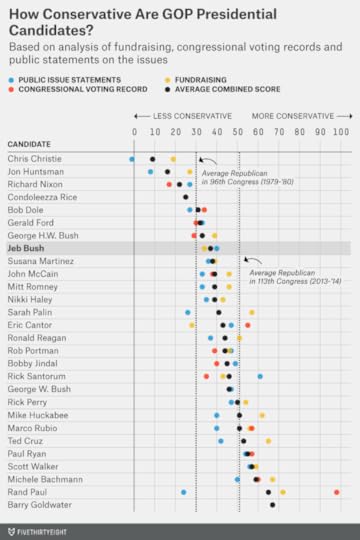
Bush scores at a 37 on this scale, similar to Romney and McCain, each of whom scored a 39. He’s much more conservative than Huntsman, who rates at a 17.
Still, Bush is more like his father, George H.W. Bush, who rates as a 33, than his brother George W. Bush, who scores a 46. And the Republican Party has moved to the right since both Poppy and Dubya were elected. The average Republican member in the 2013-14 Congress rated a 51 on this scale, more in line with potential candidates Marco Rubio, Paul Ryan and Mike Huckabee.
So as a rough cut, Bush is not especially moderate by the standard of recent GOP nominees. But the gap has nevertheless widened between Bush and the rest of his party.
On the two issues where he has most outspokenly deviated from his party, immigration and education, his policy positions are not far removed from those Republican voters declare in polls. But these issues may also take on symbolic significance beyond their immediate policy implications, signaling to Republican voters that a candidate is too moderate or too much a part of the establishment. Earlier this year, my colleague Harry Enten found Republican senators who have adopted Bush’s moderate stance on immigration have been especially likely to receive primary challenges.
And Bush has been more like Hunstman than Romney in explicitly critiquing the direction of his party. That may appeal to general-election voters, but it probably isn’t helpful to him in a Republican primary.
Still, parties have shown some historical tendency to nominate successively more moderate candidates the longer they’ve been out of the White House. That could help Bush. While he’s somewhat to the left of the average Republican politician, there’s also less competition on that side of the GOP spectrum; most Republican senators and governors first elected during the past several election cycles have been quite conservative.
That’s not to say he has the field all to himself. Romney has sometimes been considered a 2016 candidate. So has New Jersey Gov. Chris Christie (who rates as being far more moderate than Bush on our scale). New Mexico Gov. Susana Martinez has less of a national profile, but also overlaps ideologically with Bush.
Perhaps more important is the relatively early date of Bush’s announcement. If he builds an early advantage in the “invisible primary,” he could deter some of these candidates from running and make it harder for them to gain momentum if they do. The early announcement will also give Bush more time to calibrate his positions while under comparatively little scrutiny.
There will almost certainly be some credible candidates to Bush’s right, like Ryan or Rubio or Bobby Jindal or Scott Walker. Roughly 31 percent of Republican primary voters describe themselves as moderate or liberal, potentially enough to leave Bush as one of two or three remaining viable nominees after the first few states vote in 2016. That’s when he’d have to do his best campaigning — by pivoting to his right, or by convincing Republicans that his electability outweighs ideological purity. Bush may face more vigorous competition on his right in 2016 than Romney did in the likes of former Pennsylvania Sen. Rick Santorum and then-Texas Gov. Rick Perry in 2012. And to the extent that Republican voters have shifted slightly further to the right over the past four to eight years, that could make his task harder at the margins.
Betting markets put Bush’s chances of winning the Republican nomination at 20 percent to 25 percent, which seems as reasonable an estimate as any. You can get there by assuming there’s a 50 percent chance that he survives the “invisible primary” and the early-voting states intact and a 40 percent to 50 percent chance that he wins the nomination if he does. It’s a strategy that worked well enough for McCain and Romney.

December 11, 2014
Week 15 NFL Elo Ratings And Playoff Odds
Remember the Seattle Seahawks? For all 137.6 decibels of noise at CenturyLink Field, they’ve been relatively quiet this year. The Seahawks have been one of the most consistent teams in the NFL, rarely blowing anybody out and rarely getting blown out.
 Seattle’s 24-14 win in Philadelphia on Sunday was typical of its season. The Seahawks faced an excellent opponent — they’ve had one of the league’s tougher schedules — and they won clearly and cleanly, although not overwhelmingly. It was their sixth win in seven games. During that time, the Seahawks have gone from modest underdogs to make the playoffs to 94 percent favorites to do so.
Seattle’s 24-14 win in Philadelphia on Sunday was typical of its season. The Seahawks faced an excellent opponent — they’ve had one of the league’s tougher schedules — and they won clearly and cleanly, although not overwhelmingly. It was their sixth win in seven games. During that time, the Seahawks have gone from modest underdogs to make the playoffs to 94 percent favorites to do so.
Seattle has also nearly regained the top spot in FiveThirtyEight’s NFL Elo Ratings. The New England Patriots, who scored their own impressive victory over the San Diego Chargers, remain in No. 1, but it comes down to decimal points. The Patriots’ Elo rating is 1717.1; the Seahawks’ is 1716.6. The Denver Broncos remain in third and the Green Bay Packers in fourth.
But although the Seahawks’ playoff chances were once imperiled, the Elo ratings were never down on their quality. Seattle started the season at No. 1 and fell only as far as No. 3 in the league before moving back into a near-tie for first place. Seattle didn’t fall that far, in part, because Elo factors in a team’s preseason standing. (Preseason estimates are based on where the teams stood at the end of 2013.)
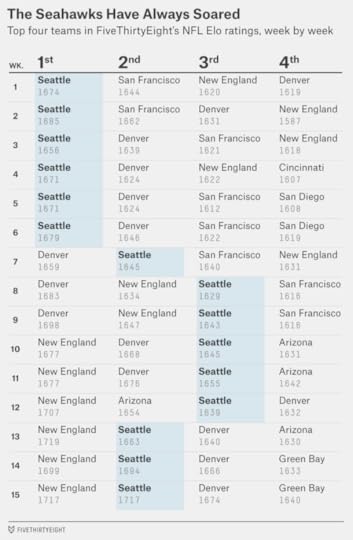
Seattle isn’t the only team that testifies to the value of accounting for preseason expectations. Among Elo’s preseason top four, Denver has remained in the top four every week of the season, and the Patriots have remained in the top four during all but two weeks.
Meanwhile, teams that looked average to start the year before making a charge up the standings, such as the Dallas Cowboys and Kansas City Chiefs, have since fallen back into the middle of the pack. The only real exception has been the Packers, and Elo has a good excuse for them, because the system doesn’t account for the injury to Aaron Rodgers that harmed their 2013 performance and depressed their preseason rating.
The Seahawks still have some regular-season work left: They’d much rather enter the playoffs as division winner, which would allow them to play as many games as possible at CenturyLink Field and probably get a first-round bye. Our simulation has Seattle with a 23 percent chance of repeating as Super Bowl champions if they win the NFC West, but just a 10 percent shot if they enter the playoffs as a wild card team.
But Seattle’s situation is a little more favorable than it might appear from the NFC West standings. Although they’re a game behind the Arizona Cardinals, the Seahawks have beaten them once this season and will play them again Dec. 21. If Seattle wins that game, it’ll make up the game against Arizona and also clinch the head-to-head tiebreaker. Seattle rates as a slight favorite in that game even though it’s being played in Arizona, so it’s a slight favorite to win the division, too, per Elo.
Here are the playoff odds for the Seahawks and the other 31 NFL teams:
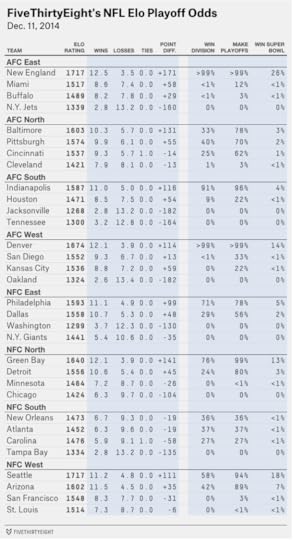
No team has clinched a playoff berth so far, although some are all but certain to make it. The Packers reached the playoffs in 98.7 percent of our simulations this week. And both the Broncos and the Patriots made it 99.9 percent of the time.
Some other team will make the playoffs in far less glorious fashion. The 5-8 Atlanta Falcons, 5-8 New Orleans Saints and 4-8-1 Carolina Panthers are still competing for the division title in the NFC South; the “champion” will not only make the playoffs, but host a home game. The best the NFC South champion can do is an 8-8 record; there’s a 31 percent chance of that, according to our simulations. There’s a 59 percent chance the division winner finishes with just seven wins, and a 10 percent chance they’ll have only six wins (either a 6-10 record or 6-9-1 in the case of Carolina). For the rundown on everyone else — including this week’s extremely high-leverage games in the NFC East and AFC South — check out Mike Beuoy and Reuben Fischer-Baum’s playoff implications column.
Elo point spreadsRecord against point spread: 105-86-3 on season (10-5 in Week 14)
Straight-up record: 144-63-1 on season (12-4 in Week 14)

Elo has been on a hot streak in Las Vegas; the point spreads the system spits out have been on the right side of the closing Vegas line about 55 percent of the time this year.
This is almost certainly just blind luck. The system isn’t as sophisticated as what bookmakers use, and Elo only beat the point spread 51 percent of the time in our backtesting of it — not enough to make a profit after the casino’s take.
But this has been a fairly predictable NFL season; for the most part, the teams that looked best when it began look the best now.
CORRECTION (Dec. 11, 10:29 a.m.): A previous version of this article incorrectly said New England has remained in Elo’s top four every week of the season. It has remained in the top four during all but two weeks.

December 7, 2014
College Football Playoff: Final Thoughts And National Championship Odds
The field for the first-ever college football playoff was announced Sunday, and Alabama, Oregon, Florida State and Ohio State have made it — leaving out TCU and Baylor.
A quick reflection on the teams the committee chose in a moment; first, let’s look forward to the playoff. Here’s how ESPN’s Football Power Index (FPI) assesses the national championship odds:
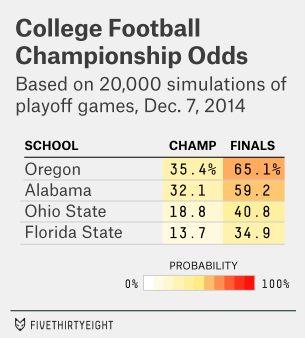
Oregon is ranked first in FPI, although just barely over Alabama. FPI also thinks the Ducks are helped slightly by getting to play No. 3 seed Florida State in the semifinals; it has Florida State rated below Alabama’s opponent, No. 4 Ohio State.
There is no runaway favorite. Oregon has a 35 percent chance of becoming the national champion, according to FPI, with Alabama at 32 percent, Ohio State at 19 percent and Florida State at 14 percent.
As for which teams made the field, one of the big things we were going to learn this weekend was how heavily the committee weighed its previous rankings when deciding on its final ones.
Because the playoff committee is new, the FiveThirtyEight playoff model was based on a historical assessment of the Coaches Poll instead. In the Coaches Poll — and the AP poll — the rankings are quite “sticky” from week to week. Voters in those polls rarely engage in top-to-bottom reassessments of the field; instead, they’ll demote teams after they lose and sometimes move them up an extra position or two after a big win. Otherwise, they’re left in about the same order.
Based on that assumption, Ohio State had a decent shot to make the playoff after its big win against Wisconsin in the Big Ten championship. But the model had TCU favored to make the playoff because it had been ranked No. 3 by the committee entering the weekend. The model had No. 4 Florida State as the more vulnerable team instead, simply because it had been ranked lower by the committee to begin with and its win Saturday — it beat Georgia Tech 37-35 for the ACC championship — was the narrowest of anyone in the top six.
Instead, Florida State moved up to No. 3. And TCU was overtaken not just by Ohio State and Florida State, but also by Baylor (which missed the playoff but was given the committee’s No. 5 ranking for posterity). What the committee did last week — promoting TCU into the No. 3 position ahead of Florida State — proved to be a head fake.
In other words, the committee appears to engage in a more thorough reassessment of the teams with its final rankings. For better or worse, it’s more concerned about getting the “right” answer in the end than in being consistent from week to week.

FiveThirtyEight’s Final College Football Playoff Forecast
We ran the FiveThirtyEight college football playoff model in the early hours of Sunday, after Ohio State and Florida State won their conference championship games. It found there is some actual drama in how the teams might be ranked by the selection committee later Sunday. Ohio State’s 59-0 win over Wisconsin in the Big Ten Championship was just the sort of performance that could compel the committee to think about whether the Buckeyes ought to get in ahead of Florida State or TCU in the four-team playoff.
Here’s how the model has the playoff odds:
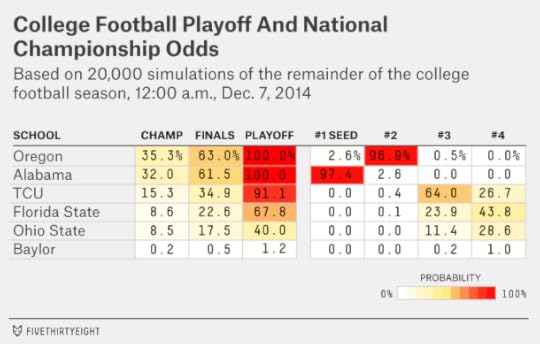
As I mentioned earlier, I think the model is too sure about TCU and too bearish about Florida State. Florida State’s win over Georgia Tech for the ACC championship came by a narrow margin, but Georgia Tech was a formidable opponent. TCU won by a more impressive scoreline — 55-3 — but that win was against an awful opponent, Iowa State. Perhaps more importantly, the Seminoles are undefeated this season and have won 29 consecutive football games.
That the committee chose to promote TCU to No. 3 last week (ahead of Florida State) may turn out to matter. Had TCU stayed at No. 4 — and Florida State at No. 3 — the model would have Ohio State favored to surpass the Horned Frogs and join Alabama, Oregon and Florida State in the playoff.
I agree with the model’s view that Baylor’s chances of making the playoff are remote, despite it having beaten TCU on Oct. 11. Had the committee thought the head-to-head win outweighed everything else, it would presumably have had Baylor rated ahead of TCU to begin with. More troublesome for Baylor: The committee could sidestep the argument about the head-to-head result by excluding both Big 12 teams from the playoff and instead going with Alabama, Oregon, Florida State and Ohio State.
We did want to issue a final forecast on how the committee might rank the entire Top 25, accounting for Boise State’s post-midnight victory in the Mountain West championship game, along with the wins by Ohio State and Florida State. The rankings could potentially affect the rest of the college football bowl lineup even if they don’t have implications for the top four. Those numbers are below:
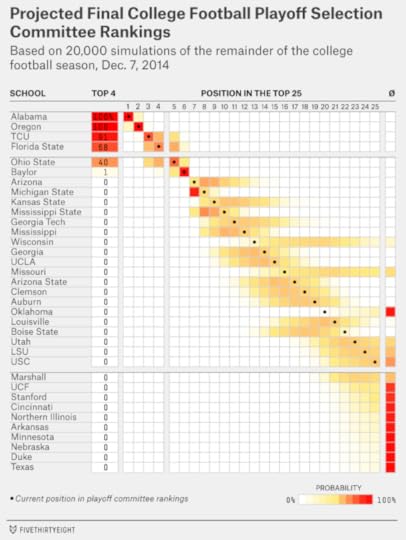
It’s interesting to contemplate which teams would make the playoff if six or eight teams were allowed to qualify for it instead of four. We’ll have more to say about this later, but this year’s messy outcome wasn’t necessarily a fluke. On average since 1996 (a year that arguably ushered in the “modern” era of college football; it was when the Southwest Conference dissolved and the sport adopted its overtime rules), there have been six teams that finished with zero or one losses from a “major” conference or went undefeated in another conference. These are the teams that would usually receive the most serious playoff consideration. Sure, this is an imperfect metric — sometimes you’ll have a two-loss team (like Stanford in 2013) that played such a tough schedule that it deserves to be considered for the playoff. Sometimes you’ll have one-loss team from a major conference that played such a soft schedule that it doesn’t have many excuses for having that one loss. But fundamentally, a four-team playoff when there are five “major” conferences is liable to be problematic.
A six-team playoff would be easy as pie this year: Alabama, Oregon, TCU, Florida State, Ohio State and Baylor would be almost certain to qualify in some order. An eight-team playoff would be more interesting: Michigan State and Mississippi State would be the most likely candidates to be the extra teams, but Mississippi and Arizona could make an argument. No number of playoff teams — from two to 16 — is going to be perfect. But a four-team playoff may prove especially dissatisfying.
CORRECTION (Dec. 7, 11:42 a.m.): An earlier version of the full final ranking table was incorrect. For teams currently ranked Nos. 5-25, the projected “position in the Top 25″ squares were displaying simulations from before this weekend’s games. The table has been updated.

December 6, 2014
College Football Playoff Update: Does Ohio State Have A Shot?
As of early Saturday evening, the college football playoff picture seemed reasonably straightforward. Alabama and Oregon won their conference championships easily. And TCU’s dominant win over Iowa State would seemingly make it hard for the committee to drop a team they’d ranked No. 3 previously out of the four-team playoff entirely.
But the Ohio State Buckeyes have made the committee’s job tricky. Their 59-0 win over No. 13 Wisconsin in the Big Ten Championship game — a dominant performance against a good opponent — just might be enough to compel the committee to reconsider.
Here’s what we know, or at least we think we know:
Alabama and Oregon will earn two of the four playoff positions. They’ll very probably be ranked in that order (Alabama at No. 1 and Oregon at No. 2).Baylor probably won’t make it. The Bears had a nice win of their own on Saturday, defeating No. 9 Kansas State 38-27 at home in Waco, Texas. But Baylor was ranked No. 6 heading into the weekend and the team ranked just ahead of them, Ohio State, couldn’t have been any more impressive. Excluding Baylor will cause some controversy since they beat TCU earlier in the year, but it’s the Buckeyes that will put more pressure on the committee.That leaves us with three teams — TCU, Florida State and Ohio State — competing for two open positions. (Florida State also won on Saturday, defeating Georgia Tech 37-35 for the ACC Championship, but it was the narrowest win of anyone in the top six.) Here’s how the FiveThirtyEight model sorts everything out:

The model has TCU with a 91 percent chance of making the playoff, Florida State with a 68 percent chance, and Ohio State with a 40 percent chance. It gives Baylor just a 1 percent shot.
TCU’s position would seem to be the safest of the three, but it’s less safe than it appeared earlier on Saturday, when the Horned Frogs’ chances were as high as 98 percent. Although TCU dominated Iowa State, the Cyclones were by far the weakest opponent that anyone in the top six faced. The committee could also sidestep the whole TCU-vs.-Baylor debate entirely by excluding both Big 12 teams from the playoff.
Florida State’s narrow win was characteristic of its entire season. Computer rankings don’t like the Seminoles that much because they’ve won by middling margins against mediocre opponents. Georgia Tech was a good opponent, but this win was also narrow.
Still, concerns about schedule and “game control” aside, would the committee really deny a 13-0 Florida State team a slot in the playoff entirely? Especially given that they’re the defending national champions and were also undefeated last year? Florida State, in fact, has not lost a football game in more than two years — they have a 29-game winning streak.
The model says it’s possible — after all, the committee has twice had other teams leapfrog Florida State even after it won. But the model isn’t considering the political implications of leaving a team with a 29-team winning streak out of the playoff.
Personally, I think the Seminoles are slightly safer than the model implies, while TCU is slightly less safe. But Ohio State has at least given the committee something to think about. They and Baylor will ensure the calls to expand the playoff to 6 or 8 teams will come soon, and forcefully.

College Football Playoff Update: Three Teams Are Fighting For The Last Spot
So far, college football’s selection weekend has been anticlimactic. Alabama’s wire-to-wire win against Missouri in the SEC Championship will assure it a place in the college football playoff. It will be joined by Oregon, which thrashed Arizona on Friday, and very likely by TCU, which won earlier on Saturday.
The Crimson Tide will presumably also retain their No. 1 ranking and enter as the top seed. Oregon’s win was impressive also — and came against a slightly better opponent. But the committee would have to make some awfully fine distinctions to promote the Ducks ahead of an Alabama team that also won persuasively. The FiveThirtyEight college football playoff model gives Alabama a 98 percent chance of keeping the top position. Here are the latest odds:
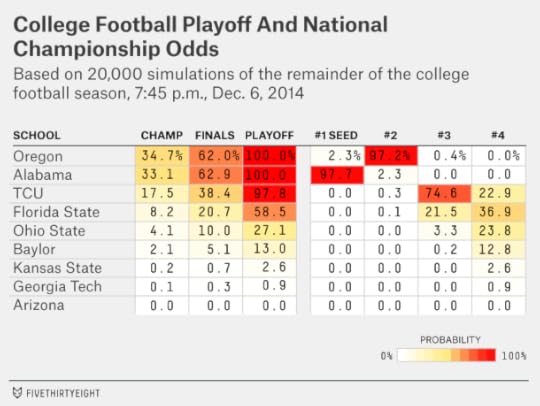
Unless TCU’s position is more vulnerable than the model assumes, that means there are effectively three teams — Florida State, Ohio State and Baylor — competing for just one open slot.
Florida State, which is undefeated but entered the weekend ranked No. 4 by the committee, is probably in with a win in the ACC Championship against Georgia Tech. True, the committee has twice demoted the Seminoles after they won by less-than-impressive margins, but those came against worse opponents than Georgia Tech.
The scorelines in the Ohio State and Baylor games could matter. If both teams win while Florida State loses, the one that does so more emphatically could get the last slot. And they’ll need to win big in any scenario where they overtake TCU or Florida State in the rankings, at least according to the model.
On the flip side: what if Florida State, Ohio State and Baylor all lose? It’s not impossible; all three are relatively narrow favorites. Florida State would still have just one loss and would probably make the playoff. But Georgia Tech — and Baylor’s opponent, Kansas State — could enter the conversation also. Ohio State’s opponent, Wisconsin, is less likely to do so because it entered the weekend ranked just No. 13.
Alabama and Oregon are now effectively co-favorites to win the national title. The FiveThirtyEight model gives Oregon a 35 percent chance and Alabama a 33 percent chance.

College Football Playoff Update: Is TCU A Lock?
TCU was ranked No. 3 in the college football playoff selection committee’s rankings entering the weekend, and as expected, it demolished Iowa State on Saturday afternoon. But the enormous margin of victory — 55-3 — isn’t quite as impressive considering the meager quality of the opposition (Iowa State finished its season 2-10). Still, the math might seem to be straightforward. TCU isn’t going to be demoted two positions in the rankings and lose its playoff spot after such a dominant performance, is it?
According to FiveThirtyEight’s college football playoff forecast model, it probably won’t. Instead, the model has TCU with a 98 percent chance of making the playoff. Here’s the latest forecast:
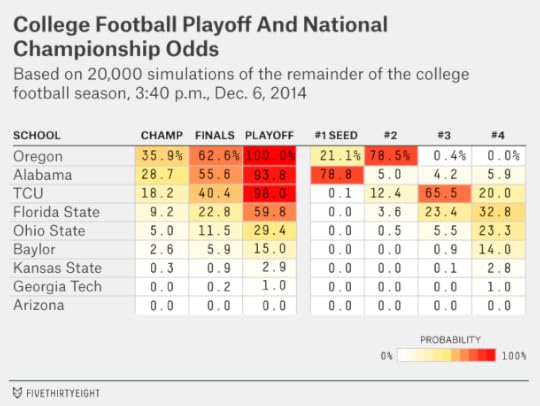
What if No. 5 Ohio State and No. 6 Baylor also win? Even then, TCU’s odds would be 96 percent, according to the model. The Horned Frogs aren’t quite as safe as Oregon, but they’re in a pretty flush position — unless, of course, a central assumption in the model is wrong. The assumption is that the committee’s standings will be fairly consistent from week to week; that it won’t, for example, suddenly give more emphasis to Baylor’s head-to-head win over TCU after indicating earlier that other factors outweighed it in TCU’s favor.
We make that assumption because that has historically been true of voters in the Coaches Poll. Because the playoff committee is new this year, the record of the Coaches Poll is the best approximation we have available. And indeed, the committee has mostly behaved like the Coaches Poll and media polls so far this year. True, it may reward slightly different factors — putting more emphasis on quality wins and “game control,” for instance. But it hasn’t reshuffled its standings drastically from week to week without a good reason.
Maybe Ohio State and Baylor could give the committee a good reason? If they also win their games, they’ll have done so against much better opponents (No. 13 Wisconsin and No. 9 Kansas State) than the one TCU just faced.
In fact, the model assumes that the committee would potentially give a little more credit to Ohio State’s and Baylor’s wins, especially if they came by clear margins. It just doesn’t think it’ll give them enough extra credit to allow them to leapfrog the Horned Frogs.
It might be a different story if TCU had started the weekend ranked No. 4 instead of No. 3. But the extra breathing room the committee gave to TCU makes it a lot safer, at least in the model’s estimation.

College Football Playoff Update: Oregon Makes A Case For No. 1
College football fans aren’t habituated to the rhythm of a playoff — at least not in the same way college basketball fans are before the NCAA tournament. But the games Saturday and the selection committee’s choices Sunday will determine the four teams that enter the first-ever college football playoff. FiveThirtyEight will be here throughout the weekend to update our forecast on which teams are most likely to make it.
The math has become simpler after Oregon’s emphatic 51-13 victory Friday night against Arizona in the Pac-12 championship game. Instead of seven teams competing for four positions, there are now effectively five teams — Alabama, TCU, Florida State, Ohio State and Baylor — competing for three slots, with Oregon having secured its position and Arizona out of the running.
Nothing’s official yet, but in this case, our statistical model aligns with common sense. Oregon, No. 2 in the selection committee’s rankings entering the weekend, made the playoff in all 20,000 simulations that we ran Saturday morning. Arizona, which now has three losses, never did. Here are the latest numbers:
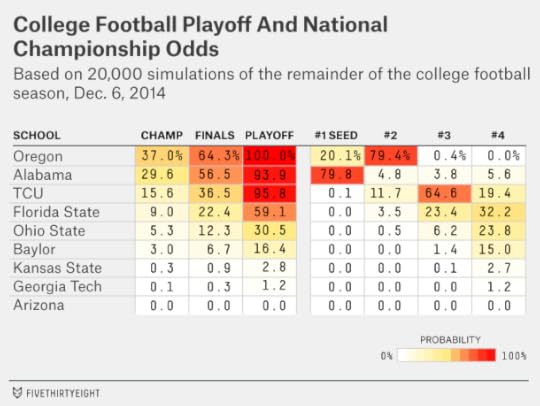
For comparison’s sake, here’s our forecast before the Pac-12 championship:
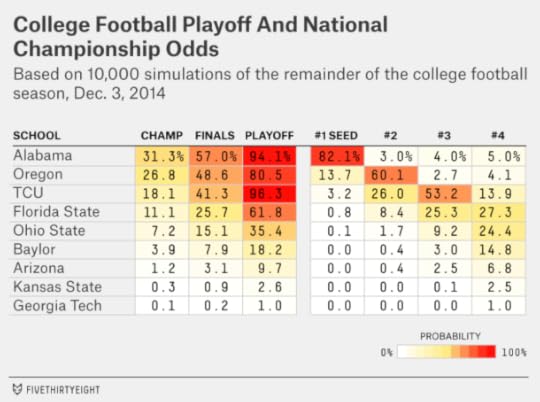
It’s become crowded at the top. No. 1-ranked Alabama is an 82 percent favorite to beat Missouri in the SEC championship, according to ESPN’s Football Power Index (FPI). And the Crimson Tide are more likely than not to make the playoff even if they lose to Missouri.
Third-ranked TCU probably won’t make the playoff if they lose to 2-9 Iowa State. But they’re 97 percent favorites to win the game, per FPI. Crazy things can happen in college football — but if the Cyclones win, it would be perhaps the most memorable college football upset since Appalachian State beat Michigan in 2007.
For the time being, Oregon is the favorite to win the national championship, with a 37 percent chance of doing so. (Alabama may overtake the Ducks if they defeat Missouri, but Oregon’s dominance against Arizona is likely to impress FPI, as well as Vegas oddsmakers.)
Oregon’s win is also modestly bad news for the teams ranked No. 5 and 6 entering the weekend, Ohio State and Baylor, because they now have one fewer opportunity to leapfrog other teams in the rankings. Ohio State’s probability of making the playoff dropped to about 30 percent from 35 percent after Oregon’s win; Baylor’s declined slightly, to about 16 percent from 18 percent.
Still, Oregon’s gain came mostly at the expense of Arizona. The result wasn’t a total disaster for Ohio State and Baylor, in part because an Arizona win would have created a mess of its own. Arizona, No. 7 entering the weekend, would have had an argument for making the playoff if it beat Oregon. Oregon might have had an argument even with a loss.
But Oregon won. Could the Ducks wind up with the No. 1 seed? They almost certainly will if Alabama loses to Missouri. Otherwise, they’ll probably stay at No. 2, according to the model. But the FiveThirtyEight model is calibrated based on a historical analysis of voting in the Coaches Poll. The playoff selection committee has been a bit more aggressive so far in promoting teams after dominant victories. Perhaps if Alabama wins clumsily against Missouri, the Ducks could overtake it. Either way, it was a happy Friday night in Eugene.

Nate Silver's Blog
- Nate Silver's profile
- 729 followers



